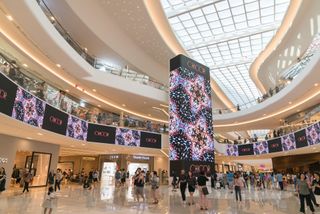We’ve seen some pretty cool products come out in 2018 due to new technologies. 4K, 8K, 10K, all the Ks are making room for upgrades in the visual world. Immersive audio—as seen in SCN’s November 2018 issue—is still making (sound) waves.
According to AVIXA, there are six vertical markets predicted to grow in big ways over the next few years: corporate, venues, retail, education, transportation, and hospitality; in 2018 alone, AVIXA says corporate and venues brought in roughly $67 billion in revenue. But what do AV professionals see trending in their day-to-day on-the-job work?
Huddle Up
The industry can’t stop talking about huddle rooms and meeting spaces, which should come as no surprise since there are close to 11 million meeting rooms across Western Europe and North America, according to Futuresource Consulting. Combine the large number of meeting rooms with this factoid—also from Futuresource—20 percent of meeting room budgets are now being spent on collaborative technologies, and integrators have an instant recipe for success.

“Technology will only become more critical to meeting rooms and huddle spaces going forward,” said Loren Shaw, VP of marketing, InFocus. “Partners, clients, and stakeholders expect efficient, dependable, and most of all flexible communication options, while the ability to wirelessly cast content, video conference, use apps, and access the cloud has become essential to nearly any workplace. As connected projectors and collaboration displays like Mondopad make this functionality more accessible to small businesses, startups, and enterprises, there’s a great opportunity for integrators to capitalize on sales and installations of new collaboration display products.”
Adam Cuzzort, CTO, solutions for Prysm, believes 2019 enterprise purchasing decisions for meetings rooms will be driven by unified, all-in-one solutions. “From AV and beyond, it is no longer about siloed technology purchases, but fully backed platforms combining hardware and SaaS capabilities.”
LED Shines Bright
The market for LED displays is rapidly growing, says Futuresource; the firm believes LEDs are “more than just a disruptor,” and saw 18 percent year-over-year growth in 2017, with more to come over the next several years.
“The introduction of MicroLED by Sony in 2016 caused a great stir of excitement in the industry, but it was thought to be a measure of what was possible, not what was viable in the near term,” said Chris McIntyre-Brown, associate director at Futuresource Consulting. “However, this year has seen far more buzz around new chip-on-boards (COB) solutions, MiniLED, and glue-on-board. All offer different benefits, but it is really the potential of MiniLED that has the industry excited. Troublingly though, are the lack of standards around MiniLED, MicroLED, and indeed the LED industry as a whole. This is creating confusion—and that certainly needs to be addressed.”

“Developments in direct-view LED are paving the way for larger displays that are both brighter and seamless, advancing into new applications,” added Kathryn Gaskell, manager, product management, Chief. “This means many people are interfacing with the technology for the first time and moving into unfamiliar territory.”
The LED industry is full of promise with Futuresource maintaining its aggressive growth forecasting out to 2022. It is now almost impossible to find a vertical market or end application where LED displays haven’t been optimized for both indoor and outdoor applications, and for good reason. “The industry is poised to take the next step in technological advancement and with that we see the LED display community beginning to wonder just how much share it can take from the giant that is the LCD industry,” McIntyre-Brown concluded.
Resimerical
Everyone’s new favorite addition to the AV dictionary—resimercial. Whereas commercial AV used to lead the path to innovation, the pro AV industry is now trying to catch up to residential and consumer products. According to Prysm’s Cuzzort, “As consumers, we’re used to the smart everything world—even our microwave will soon be powered by Alexa. This will only continue, especially in the workplace.”
Speaking of the workplace, it’s a BYOD party, and everybody wants to be invited. “By 2021, there will be more than 7.5 billion connected devices globally. Smart technology that has become popular in residential applications is now making its way into the small- and medium-sized business market,” said Mitchell Klein, executive director, Z-Wave Alliance.
One such popular trend is AI and voice-control. “Amazon Alexa and Google Home are rapidly developing third-party relationships with manufacturers in the AV and security markets, providing a simple way to establish a smart environment and offer interoperability to the end user,” according to Dennis Holzer, executive director of the PowerHouse Alliance.
With so many devices in the office, he says it is “absolutely necessary to install dynamic networks to ensure a strong and consistent signal, and too often integrators have a false sense of security when installing a new network. Networks are complex and intricate systems, and a challenging and time-consuming product category to learn.” Because this will continue to be a growing trend, he advises systems contractors to take the necessary training in order to “be successful now and into the future.”
“With the growing popularity of smart devices, we think the line between these markets will continue to blur and become more intertwined, which means systems contractors need to be a jack of all trades,” advised Mark Corbin, president, Vanco International. “There is an expectation that all of the technology in a commercial environment or residence will work together and can be monitored and controlled from the palm of the customer’s hand, or like our Spot for Dot wireless amplifier, by voice command.”
Cheers to a New Year
All signs point to an upward trajectory in the pro AV industry. Andy Banerjee, managing principal of business analytics and forecasting, IHS Markit, said at AVIXA’s AV Executive Conference, “Global economic growth is key to growth of demand for pro AV products and services, and the global GDP growth is currently at 3.2 percent and may be similar in 2019.”













